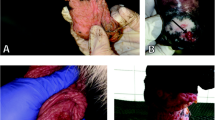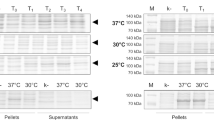Abstract
For approximately one decade, a novel papillomavirus termed Equus caballus papillomavirus-2 (EcPV-2) has been associated with equine penile/preputial papillomas and squamous cell carcinomas (SCCs). It is currently believed that the virus has a carcinogenic activity, being able to induce such neoplastic lesions. After being first described, EcPV-2 has been detected in many countries from North America, Europe, and Asia; however, to date, it has not been reported in Brazil. The aim of this research was to investigate the presence of EcPV-2 in penile/preputial papillomas and SCCs of Brazilian horses. Forty samples diagnosed as equine penile and/or preputial papillomas, carcinomas in situ (CIS), or SCCs in two veterinary anatomic pathology services from southern Brazil were investigated. Histologic evaluation and immunohistochemistry (IHC) using a BPV-1 antibody were performed. Posteriorly, the samples were submitted to polymerase chain reaction using two broad-spectrum (MY09/11 and FAP) and one EcPV-2-specific primer sets. Positive samples were sequenced. PV antigen expression was detected in one papilloma, one CIS, and two SCCs by IHC. Five SCCs, one papilloma, and one CIS were PV-positive on PCR. Sequencing of the seven PCR products revealed homology with EcPV-2. This study confirms the occurrence of EcPV-2 infection in Brazilian horses. Moreover, the results presented here provide useful information concerning the phylogeny from the viruses detected in our samples. We hope to encourage further studies on this novel agent, contributing to its characterization, and, possibly, to the eventual development of preventive measurements, including a possible vaccine.


Similar content being viewed by others
Notes
Carpinteria, CA 93,013, USA.
References
Foster RA (2016) Integumentary system. In: Maxie MG (ed) Jubb, Kennedy and Palmers’ pathology of domestic animals, V3, 6th edn. Elsevier, St Louis, pp 509.
Mauldin EA, Peters-Kennedy J (2016) Integumentary system. In: Maxie MG (ed) Jubb, Kennedy and Palmers’ pathology of domestic animals, V1, 6th edn. Elsevier, St. Louis, pp 706.
Smith M, Levine D, Getman L, Parente E, Engiles J (2009) Case report: vulvar squamous cell carcinoma in situ within viral papillomas in an aged Quarter Horse mare. Equine Vet Educ 21(1):11–16. https://doi.org/10.2746/095777309X390551
Zhang W, Yang S, Shan T et al (2017) Virome comparisons in wild-diseased and healthy captive Giant pandas. Microbiome 5:90. https://doi.org/10.1186/s40168-017-0308-0
Goldschmidt MH, Goldschmidt KH (2017) Epithelial and melanocytic tumors of the skin. In: Meuten DJ (ed) Tumors in domestic animals, 5th edn. John Wiley & Sons Inc., Ames, pp 91–99
Scase T, Brandt S, Kainzbauer C, Sykora S, Bijmholt S, Hughes K, Sharpe S, Foote A (2010) Equus caballus papillomavirus-2 (EcPV-2): an infectious cause for equine genital cancer? Equine Vet J 42(8):738–745. https://doi.org/10.1111/j.2042-3306.2010.00311.x
Alloway E, Linder K, May S, Rose T, DeLay J, Bender S, Tucker A, Luff J (2020) A subset of equine gastric squamous cell carcinomas is associated with Equus caballus papilomavírus-2 infection. Vet Pathol 57:427–431. https://doi.org/10.1177/0300985820908797
Greenwood S, Chow-Lockerbie B, Ramsauer S, Wachoski-Dark G, Knight C, Wobeser B (2020) Prevalence of Equus caballus Papillomavirus type-2 infection and seropositivity in asymptomatic western Canadian horses. Vet Pathol 57(5):632–651. https://doi.org/10.1177/0300985820941270
Knight CG, Munday JS, Peters J, Dunowska M (2013) Comparison of the levels of Equus caballus papillomavirus type 2 (EcPV-2) DNA in equine squamous cell carcinomas and non-cancerous tissues using quantitative PCR. Vet Microbiol 166:257–262. https://doi.org/10.1016/j.vetmic.2013.06.004
Sykora S, Samek L, Schönthaler K, Palm F, Borzacchiello G, Aurich C, Brandt S (2012) EcPV-2 is transcriptionally active in equine SCC but only rarely detectable in swabs and semen from healthy horses. Vet Microbiol 158(1–2):194–198. https://doi.org/10.1016/j.vetmic.2012.02.006
Greenwood S, Chow-Lockerbie B, Epp T, Knight C, Wachoski-Dark G, MacDonald-Dickinson V, Wobeser B (2020) Prevalence and prognostic impact of Equus caballus papillomavirus type 2 infection in equine squamous cell carcinomas in Western Canadian Horses. Vet Pathol 57(5):623–631. https://doi.org/10.1177/0300985820941266
Bogaert L, Willemsen A, Vanderstraeten E, Bracho M, Baere C, Bravo IG, Martens A (2012) EcPV2 DNA in equine genital squamous cell carcinomas and normal genital mucosa. Vet Microbiol 158:33–41. https://doi.org/10.1016/j.vetmic.2012.02.005
Knight CG, Munday JS, Peters J, Dunowska M (2011) Equine penile squamous cell carcinomas are associated with the presence of equine papillomavírus type-2 DNA sequences. Vet Pathol 48:1190–1194. https://doi.org/10.1177/0300985810396516
Lange CE, Tobler K, Lehner A, Grest P, Welle MM, Schwarzwald CC, Favrot C (2012) EcPV2 DNA in equine Papillomas and in situ and invasive squamous cell carcinomas supports papillomavirus etiology. Vet Pathol 50:686–692. https://doi.org/10.1177/0300985812463403
Lee SK, Lee JK, Lee I (2019) Molecular detection of Equus caballus papillomavirus type 2 in genital swabs from healthy horses in the Republic of Korea. J Equine Vet Sci 72:97–100. https://doi.org/10.1016/j.jevs.2018.10.015
Newkirk K, Hendrix D, Anis E, Rohrbach BW, Ehrhart EJ, Lyons JA, Kania SA (2014) Detection of papillomavírus in equine periocular and penile squamous cell carcinoma. J Vet Diagn Invest 26:131–135. https://doi.org/10.1177/1040638713511618
Yamashita-kawanishi N, Ito S, Chamers JK, Uchida K, Sato M, Chang HW, Knight C, Meer F, Haga T (2021) Vulvar squamous cell carcinoma associated with Equus caballus papillomavirus type 2 infection in a Japanese mare. Tumour Virus Research 12:200226. https://doi.org/10.1016/j.tvr.2021.200226
Silva MS, Weiss M, Brum MCS, Anjos BL, Torres FD, Weiblen R, Flores EFF (2010) Molecular identification of bovine papillomaviruses associated with cutaneous warts in southern Brazil. J Vet Diagn Invest 22:603–606. https://doi.org/10.1177/104063871002200417
Kumar S, Stecher G, Li M, Knyaz C, Mega Tamura K (2018) X: molecular evolutionary genetics analysis across computing platforms. Mol Biol Evol 35(6):1547–1549. https://doi.org/10.1093/molbev/msy096
Ramos-Vara JA, Miller MA (2014) When tissue antigens and antibodies get along: revisiting the technical aspects of immunohistochemistry—the red, brown, and blue technique. Vet Pathol 51(1):42–87. https://doi.org/10.1177/0300985813505879
Pérez J, Mozos E, Martín MP, Day MJ (1999) Immunohistochemical study of the inflammatory infiltrate associated with equine squamous cell carcinoma. J Comp Pathol 121(4):385–397. https://doi.org/10.1053/jcpa.1999.0336
Santana CH, Moreira PRR, Rosolem MC, Vasconcelos RO (2016) Relationship between the inflammatory infiltrate and the degree of differentiation of the canine cutaneous squamous cell carcinoma. Vet Anim Sci 1–2:4–8. https://doi.org/10.1016/j.vas.2016.10.001
Van Den Top JG, Heer ND, Klein WR, Ensink JM (2008) Penile and preputial tumours in the horse: a retrospective study of 114 affected horses. Equine Vet Journal 40:528–532. https://doi.org/10.2746/042516408x281180
Zhu K, Affolter V, Gaynor A, Dela Cruz Jr F, Pesavento P (2015) Equine genital squamous cell carcinoma: in situ hybridization identifies a distinct subset containing Equus caballus papillomavirus 2. Vet Pathol 52(6):1067–72. https://doi.org/10.1177/0300985815583095
Wood CE, Borgerink H, Register TC, Scott L, Cline JM (2004) Cervical and vaginal epithelial neoplasms in cynomolgus monkeys. Vet Pathol 41:108–115. https://doi.org/10.1354/2Fvp.41-2-108
Acknowledgements
To the Laboratório de Patologia Veterinária (LPV) and Setor de Virologia (SV) of the Universidade Federal de Santa Maria (UFSM) and Serviço de Patologia Veterinária (SPV) of the Universidade Federal do Rio Grande do Sul (UFRGS).
Funding
This research was financially supported by Fundação de Amparo à Pesquisa do estado do RS (FAPERGS) (process number 19/2551–0001324-8), Coordenação de Aperfeiçoamento de Pessoal de Nível Superior (CAPES), and Conselho Nacional de Desenvolvimento Científico e Tecnológico (CNPq). Tanara da Silva has a scholarship from CAPES; Eduardo F Flores and Glaucia D Kommers have a fellowship from CnPQ.
Author information
Authors and Affiliations
Contributions
All authors whose names appear on the submission have made substantial contributions to the conception or design of the work, or the acquisition, analysis, or interpretation of data; drafted the work or revised it critically for important intellectual content; approved the version to be published; and agreed to be accountable for all aspects of the work in ensuring that questions related to the accuracy of integrity of any part of the work are appropriately investigated and resolved.
Corresponding author
Ethics declarations
Ethics approval
This research is within the ethical guidelines for animal welfare. Since it did not involve any experiments with live animals, it was not submitted to an ethical committee.
Consent to participate
Not applicable.
Consent for publication
Not applicable.
Conflict of interest
The authors declare no competing interests.
Additional information
Responsible Editor: Fernando R. Spilki
Publisher's note
Springer Nature remains neutral with regard to jurisdictional claims in published maps and institutional affiliations.
Rights and permissions
About this article
Cite this article
da Silva, T.R.d.O., Gonçalves, P.N.C., Marcus, V.B. et al. Detection of Equus caballus papillomavirus-2 in equine penile/preputial papillomas and squamous cell carcinomas in southern Brazil. Braz J Microbiol 53, 1707–1713 (2022). https://doi.org/10.1007/s42770-022-00769-3
Received:
Accepted:
Published:
Issue Date:
DOI: https://doi.org/10.1007/s42770-022-00769-3




